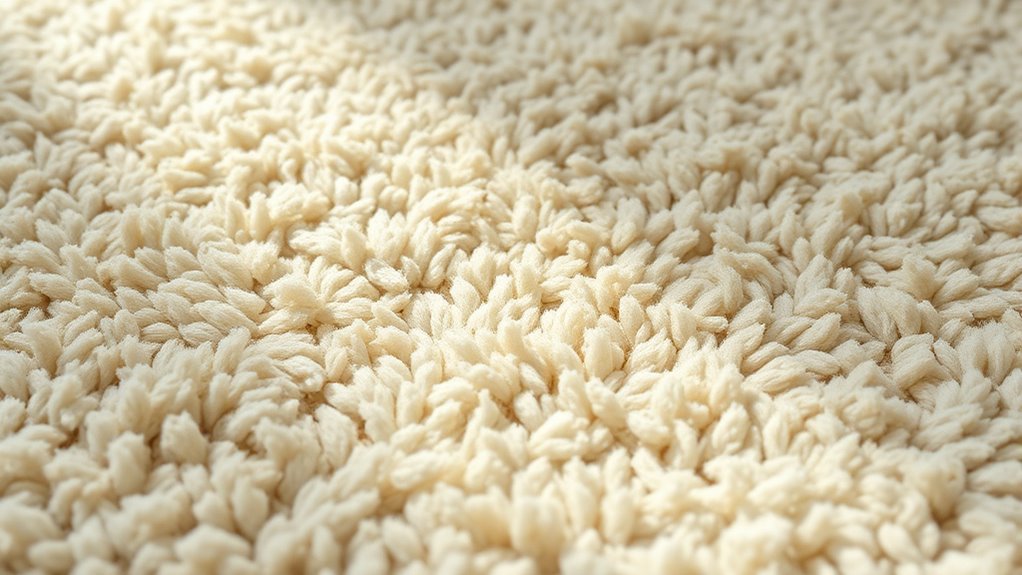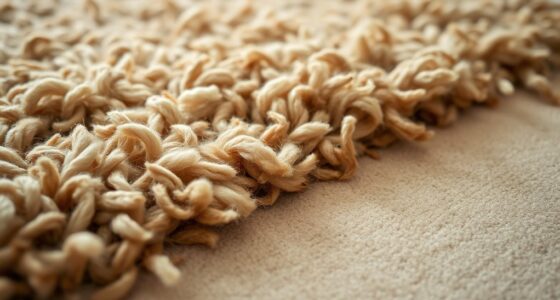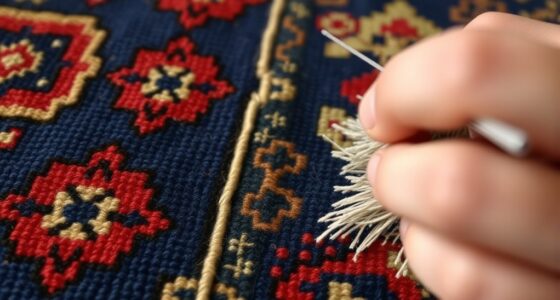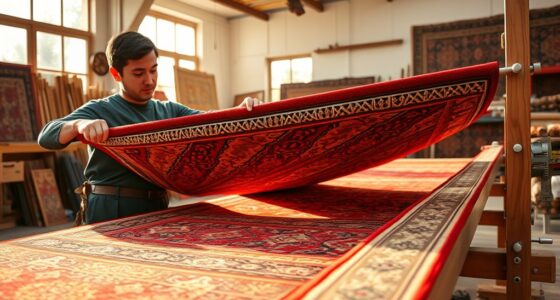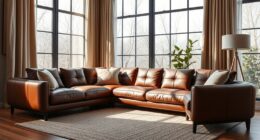If you notice uneven wear, faded colors, or thinning fibers in high-traffic areas, it’s time to rotate your rug to promote even use and prevent further damage. Look for frayed edges, discolored patches, or persistent stains that won’t come out—these signals indicate it may be time for a replacement. Regular inspection helps determine when to rotate or replace your rug. Keep going to discover more tips on maintaining your rug’s beauty and longevity.
Key Takeaways
- Rotate rugs every 3-6 months to prevent uneven wear and maintain consistent appearance.
- Look for thinning fibers, frayed edges, or bald patches indicating it’s time for rotation or replacement.
- Identify high-traffic areas with flattened fibers or faded colors to decide if rotation is needed.
- Replace rugs showing deep stains, persistent odors, large tears, or significant color fading that cleaning can’t fix.
- Monitor signs of structural damage or safety hazards, such as curling or slipping backing, to determine replacement necessity.
Common Signs of Uneven Rug Wear
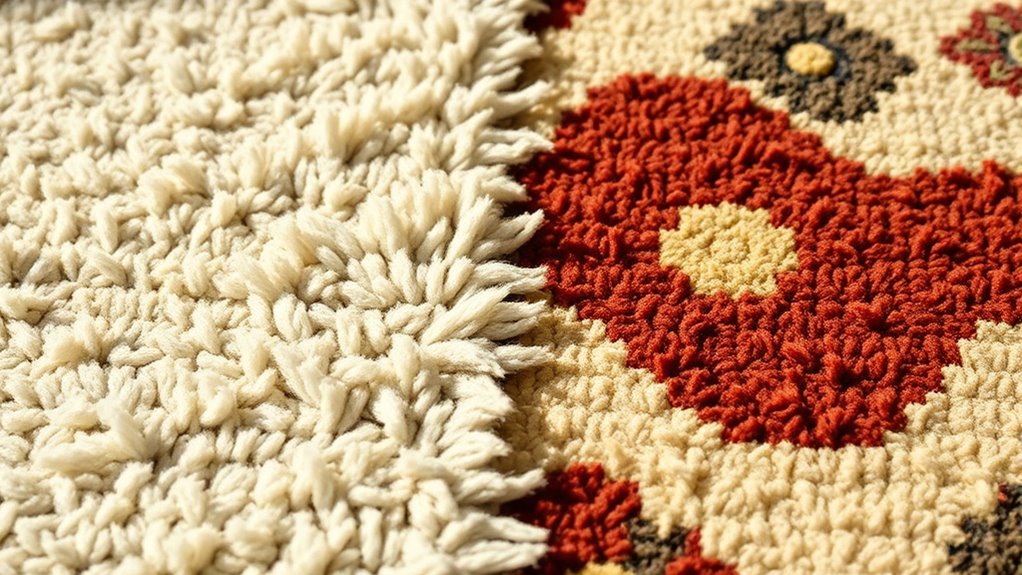
Uneven rug wear often becomes noticeable through specific signs that indicate areas of increased foot traffic or insufficient support. You might see thinning patches where rug fiber types like wool or synthetic fibers wear differently, revealing the underlying material. Over time, the dye fastness in certain sections fades faster, causing uneven coloration that highlights worn spots. Fraying edges or bald patches are clear indicators that some areas endure more stress. If you notice high-traffic zones looking flattened or discolored, it’s a sign the rug isn’t distributing weight evenly. Recognizing these signs early helps you decide whether to rotate the rug or consider replacement. Being aware of how different rug fiber types respond to wear and understanding dye fastness can prolong your rug’s lifespan. Additionally, understanding Rug Inheritance Rules can help you plan for potential repairs or replacements that optimize your investment. Proper maintenance techniques, such as regular vacuuming and gentle cleaning, can also help mitigate uneven wear and extend the life of your rug. Implementing protective pads or rugs in high-traffic areas can further reduce uneven wear and help maintain your rug’s appearance over time. Incorporating rotating your rug periodically can distribute the wear more evenly across the surface, extending its usable life.
Identifying High-Traffic Areas on Your Rug

Look for areas where the rug feels thinner or shows more wear, as these are likely your high-traffic spots. You might notice faded colors or flattened fibers in these sections. Recognizing these signs helps you pinpoint where most of the foot traffic occurs. Regularly inspecting these areas can also assist in assessing rug condition and planning appropriate care or rotation strategies. Additionally, understanding wear patterns can guide you in choosing the right rotation or replacement schedule to prolong your rug’s lifespan. Being attentive to these signs can also help you implement sustainable practices that extend the life of your rug while maintaining its beauty. By monitoring these patterns, you can make informed decisions to maximize rug longevity and preserve its appearance over time.
Spotting Worn Spots
High-traffic areas on your rug are often easy to spot because the fibers appear thinner, more compressed, or discolored compared to the surrounding areas. To identify these worn spots, perform a careful rug fiber analysis by examining the texture and color differences. Spotting worn spots involves looking for sections where fibers seem flattened or frayed, indicating frequent use. You might notice a change in sheen or a duller appearance in high-traffic zones. Pay attention to areas where the pile is considerably shorter or uneven, which can signal uneven wear. Recognizing these signs helps you determine which parts need more attention, whether that means rotating the rug or considering repair. Regularly inspecting your rug ensures you catch worn spots early, prolonging its lifespan and maintaining its appearance. Additionally, understanding furniture placement can help prevent uneven wear and extend the life of your rug. Keeping an eye on wear patterns allows for better maintenance and longevity of your rug. Proper vacuuming techniques can also significantly reduce the risk of accelerated wear in high-traffic areas.
Recognizing Frequent Traffic
Ever wonder how to spot the areas on your rug that see the most foot traffic? Look for signs like:
- Fading or color changes caused by dye migration in high-traffic zones.
- Flattened fibers that appear more worn down and less plush.
- Fraying edges or loose threads indicating fiber damage.
- Increased dirt buildup in certain spots, revealing where people walk most.
- Recognizing these patterns aligns with the concept of maximizing space and organization, as identifying high-traffic areas helps you better maintain and protect your rug’s appearance.
- Regularly rotating your rug can distribute wear more evenly and prolong its lifespan, especially in areas with frequent traffic.
- Being aware of fiber damage signs can also help you decide when professional cleaning or repair might be necessary to preserve the rug’s integrity.
These signs show which parts of your rug endure the most stress, making it clear where to rotate or reinforce. Frequent traffic accelerates fiber damage and dye migration, leading to uneven wear. Recognizing these areas helps you decide when it’s time to turn the rug or consider replacement, preserving its appearance and extending its lifespan. Additionally, understanding automation in business can inspire you to develop a routine or use tools that streamline your rug maintenance efforts.
How to Detect Fading and Color Loss

How can you tell if your rug is fading or losing its color? Look for uneven patches or a dull appearance compared to its original vibrancy. Dyes fade over time, leading to visible color loss, especially in high-traffic areas or spots exposed to sunlight. To spot dye fading, compare areas under different lighting conditions. Here’s a quick comparison:
| Indicator | What to Watch For |
|---|---|
| Dullness | Overall loss of vibrancy |
| Uneven Color | Patches with noticeably less color |
If you notice these signs, it’s likely your rug is experiencing dye fading or color loss. Regular inspection helps you decide when to take action, such as professional cleaning or rotation. Early detection keeps your rug looking fresh longer. Being aware of factors like UV exposure can help prevent further fading and preserve your rug’s appearance. Additionally, understanding fiber types can guide you in choosing appropriate cleaning methods to maintain color integrity. Recognizing wear patterns can also indicate when it’s time to rotate or replace your rug to ensure even aging and longevity. Incorporating proper cleaning techniques can further extend the lifespan of your rug’s vibrant colors.
The Impact of Furniture on Rug Wear
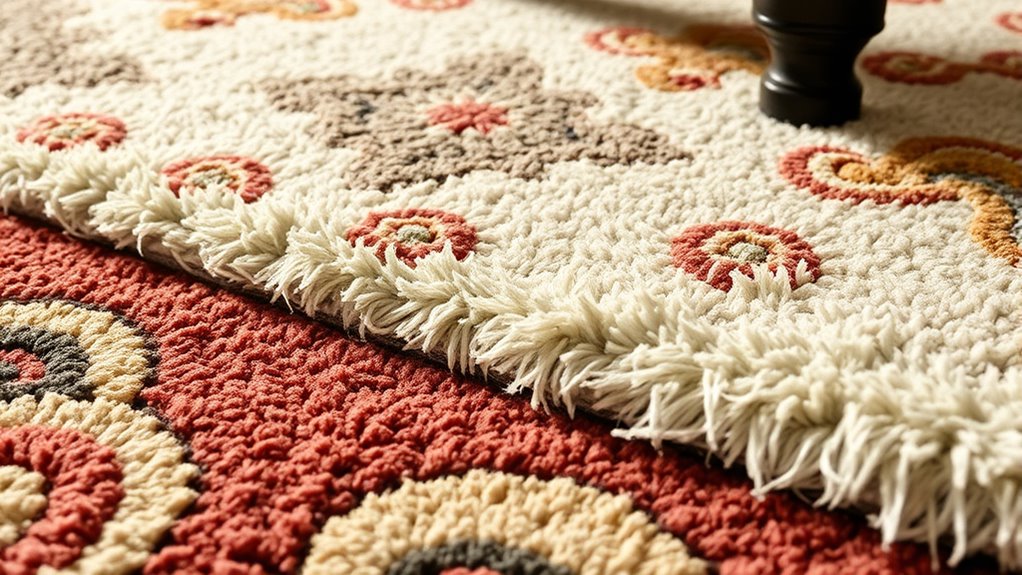
Furniture placement can considerably influence where your rug shows signs of wear. Heavy pieces and high-traffic zones tend to cause more fading and thinning over time. How weight is distributed across your rug determines which areas will wear faster. Additionally, using non-combustible materials for any rug pads or surrounding decor can help prevent fire hazards and maintain safety. Properly positioning furniture can also help protect your rug from uneven wear patterns, extending its lifespan. Being mindful of traffic flow can further distribute wear more evenly across the rug’s surface.
Furniture Placement and Wear
The placement of furniture directly influences how a rug wears over time. Heavy pieces can create uneven pressure, causing areas to thin faster or develop indentations. To protect your rug’s integrity:
- Distribute furniture evenly to avoid concentrated wear.
- Use furniture coasters or pads to reduce pressure and prevent indentations.
- Opt for a thicker area rug for high-traffic zones to improve durability and stain resistance.
- Regularly rotate furniture to promote even wear and maintain the rug’s appearance.
- Incorporate proper furniture placement strategies to further prevent uneven wear and extend your rug’s lifespan.
Choosing an area rug with appropriate thickness helps it withstand furniture weight, while stain-resistant materials keep it looking fresh longer. Proper furniture placement not only preserves your rug’s beauty but also extends its lifespan, saving you money and effort.
Heaviest Traffic Zones
Since high-traffic areas experience frequent foot traffic and constant movement, they naturally become the most vulnerable zones for rug wear. Heavy use accelerates material deterioration, making durability a key factor when selecting rugs for these zones. Furniture, especially pieces placed directly on the rug, can increase wear in specific areas by concentrating pressure. To better understand this, consider the table below:
| Zone | Material Durability | Aesthetic Considerations |
|---|---|---|
| Entryway | High | Hides wear, easy to clean |
| Under furniture | Moderate to high | Maintains appearance longer |
| Hallways | Moderate | Less visible wear |
| Living Room | Variable | Balances comfort & style |
| High-traffic Pathways | High | Resists frequent use |
Choosing rugs with suitable material durability and considering aesthetic impact helps prolong life and maintain style in these zones.
Weight Distribution Effects
When heavy or concentrated weight is placed on a rug, it causes uneven pressure that accelerates wear in those specific areas. This uneven distribution affects fiber texture and pile height, leading to visible damage. You might notice:
- Flattened pile where furniture sits, losing plushness and comfort.
- Distorted fiber texture, making the rug look worn and faded.
- Increased friction that frays fibers, causing premature thinning.
- Uneven wear patterns, which become more pronounced over time.
Furniture weight applies pressure that compresses the pile, breaking down fibers faster. To protect your rug, rotate furniture periodically, and consider using pads to distribute weight evenly, maintaining the rug’s appearance and extending its lifespan.
When to Consider Rotating Your Rug
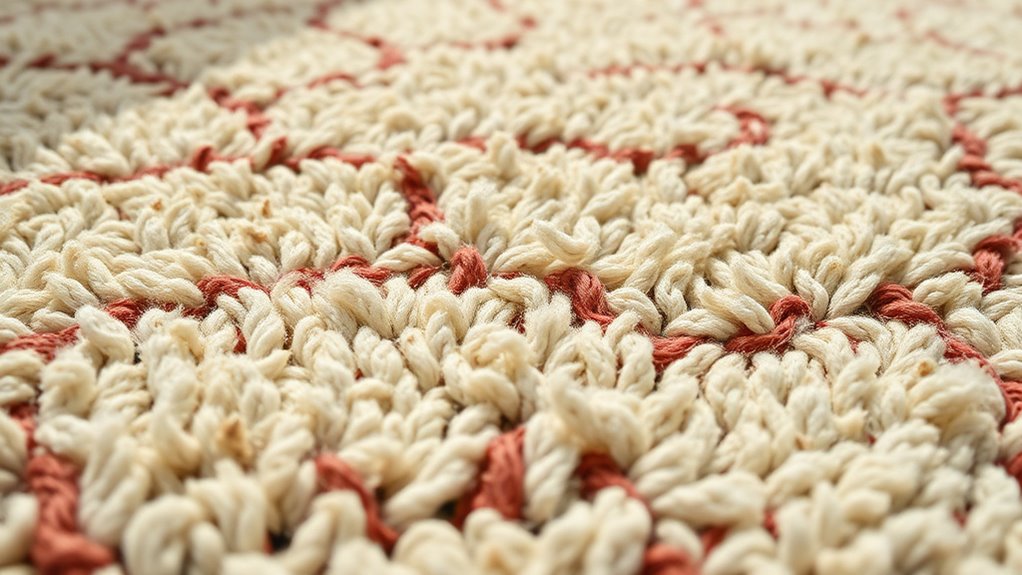
Noticing uneven wear on your rug is a clear sign it’s time to contemplate rotating it. This helps guarantee even foot traffic distribution, prolonging its lifespan. If your rug’s worn more in high-traffic areas, consider rotating it to maintain its appearance. Your decorating style might influence how often you rotate; more formal or traditional styles may require less frequent changes, while casual spaces might need more. Also, keep in mind how rug cleaning techniques can affect wear patterns. Regularly cleaning and rotating your rug prevents dirt buildup and uneven deterioration, preserving its beauty. By rotating your rug, you help it stay balanced and vibrant, aligning with your decor’s aesthetic. It’s a simple step that considerably extends your rug’s life and keeps your space looking fresh.
Techniques for Proper Rug Rotation
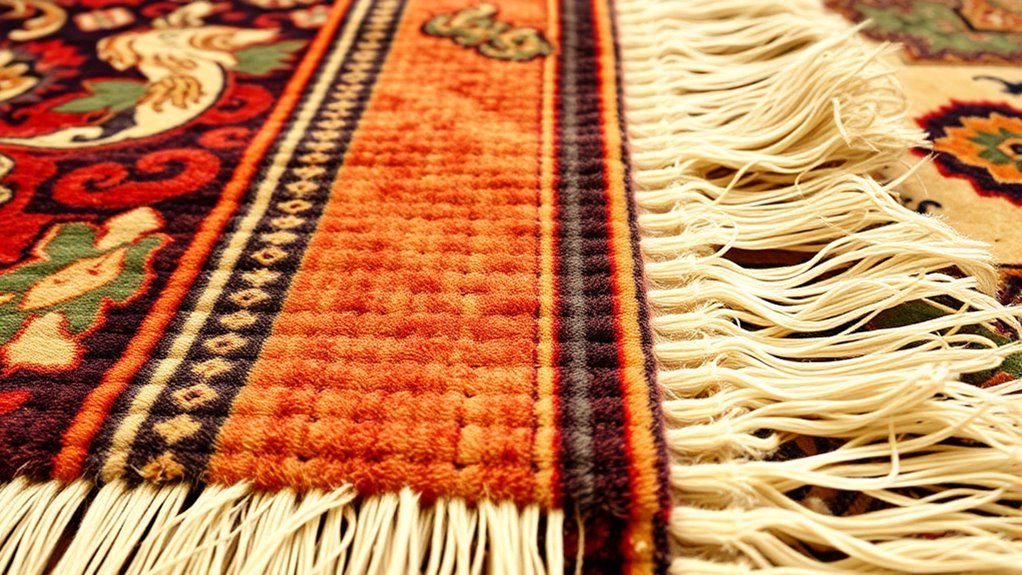
To guarantee your rug wears evenly and lasts longer, it’s important to use proper techniques when rotating it. First, determine a rotation schedule—every 3 to 6 months—so you prevent uneven color fading and fiber damage. Second, rotate the rug 180 degrees or 90 degrees, depending on traffic patterns, to distribute wear evenly. Third, avoid dragging the rug; lift it carefully to prevent stretching or fraying. Fourth, check for areas showing signs of uneven fading or fiber thinning, and adjust your rotation routine accordingly. Regularly shifting your rug ensures consistent exposure to sunlight and foot traffic, reducing the risk of color fading and fiber damage. Proper rotation keeps your rug looking vibrant and structurally sound for years to come.
Signs That Indicate It’s Time for a Replacement
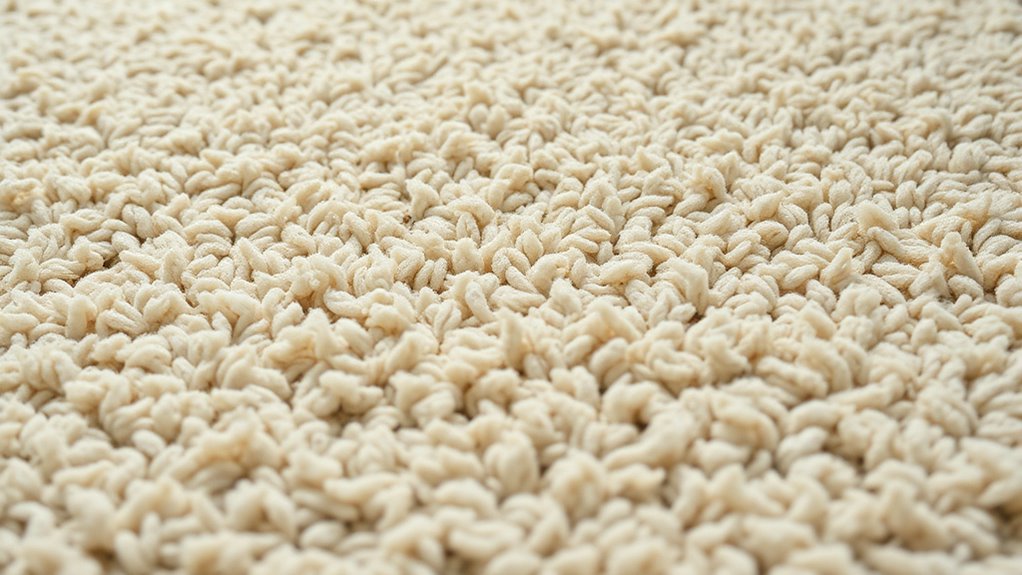
Even with proper rotation techniques, there comes a point when your rug shows clear signs it’s time for a replacement. You might notice the rug material has become frayed or thinned, losing its durability. The aesthetic appeal fades when colors are dull or patterns are worn through, making the rug less attractive. Additionally, persistent stains or odors that won’t come out signal deep-seated damage. Check the table below for common signs:
| Sign | Impact on Rug Material | Effect on Aesthetic Appeal |
|---|---|---|
| Frayed edges or thinning | Structural weakening | Looks worn-out |
| Fading colors | Loss of vibrancy | Dulls overall look |
| Persistent stains/odors | Damage to fibers | Decreases attractiveness |
| Large holes or tears | Compromises integrity | Unappealing or unsafe |
When these signs appear, it’s time to contemplate replacing your rug.
Maintaining Your Rug to Prevent Excessive Wear
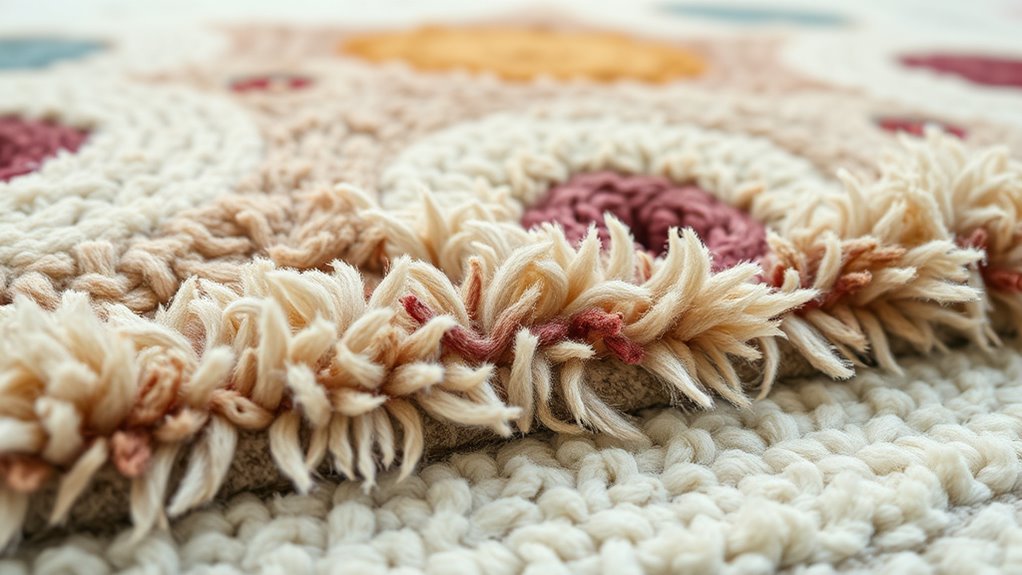
To keep your rug looking its best, establish a regular vacuuming routine to remove dirt and debris that can cause wear over time. Using rug pads can also help distribute weight evenly and prevent slipping or bunching. These simple steps make a big difference in extending your rug’s lifespan and maintaining its appearance.
Regular Vacuuming Schedule
Have you ever wondered how often you should vacuum your rug to keep it looking its best? Regular vacuuming is essential for preventing premature wear and keeping fibers healthy. Depending on your rug’s fiber types and foot traffic, consider this schedule:
- Vacuum high-traffic areas daily to avoid dirt buildup.
- Vacuum less-used rooms twice a week to maintain freshness.
- Use gentle cleaning methods for delicate fibers like wool or silk.
- Deep clean every 6-12 months to remove embedded dust and debris.
Use of Rug Pads
Using rug pads is a simple yet effective way to prevent excessive wear and extend the life of your rug. Rug pad benefits include cushioning, stability, and added protection against friction and dirt that can damage fibers. Non slip rug pads keep your rug securely in place, reducing shifting that causes uneven wear and potential tripping hazards. By providing a barrier between your rug and the floor, rug pads also help prevent color bleeding and moisture damage. Choosing the right non slip rug pads ensures your rug stays flat and well-supported, minimizing wear patterns caused by constant movement or foot traffic. Overall, incorporating a quality rug pad is a smart investment that preserves your rug’s appearance and structural integrity over time.
Selecting New Rugs With Durability in Mind
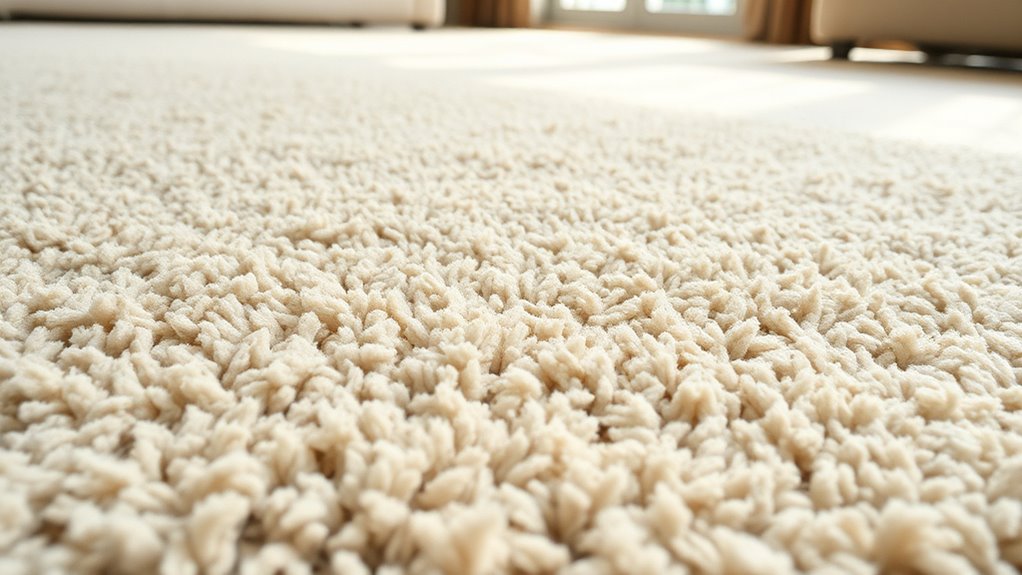
When choosing a new rug, prioritizing durability guarantees it can withstand daily wear and tear without quickly showing signs of damage. Focus on rug material selection—opt for sturdy fibers like wool, nylon, or polypropylene—that stand up to foot traffic. Consider aesthetic considerations, but don’t sacrifice quality for style; a durable rug can still be beautiful. Ask yourself:
- Will this rug handle high traffic areas without fading or fraying?
- Does the material resist stains and stain removal?
- Is the backing secure enough to prevent slipping or curling?
- Will it maintain its appearance over time, despite daily use?
Choosing a rug with these factors in mind ensures longevity. When durability is a priority, your investment becomes a source of comfort and style that lasts for years.
Tips for Extending the Lifespan of Your Rugs
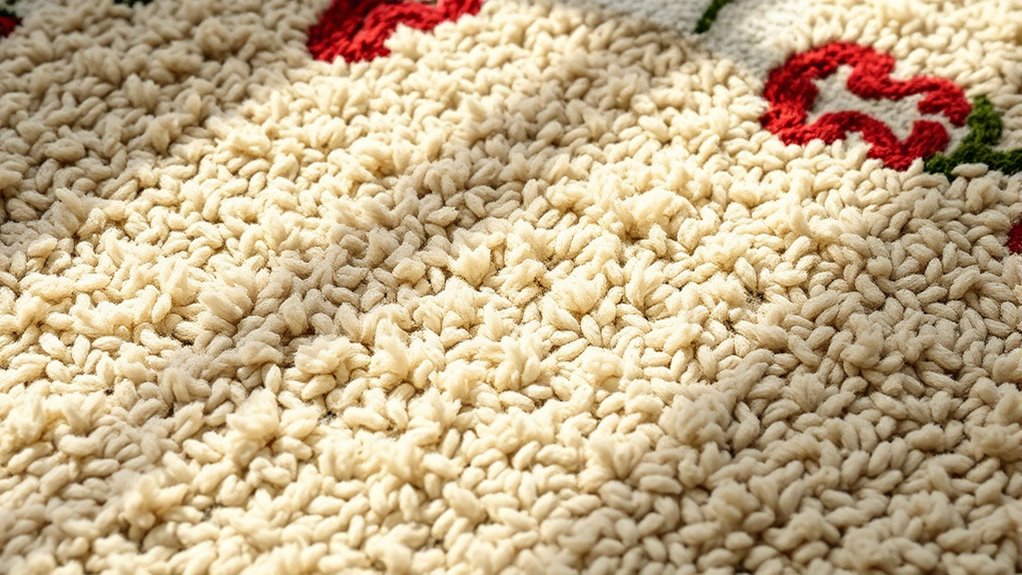
To keep your rugs looking their best for years to come, regular maintenance is essential. Rotate your rugs periodically to prevent uneven wear, especially on high-traffic areas. This helps preserve fabric patterns and reduces dye fading in spots that get the most sunlight or foot traffic. Vacuum your rug often, using gentle settings to remove dirt and debris that can wear down fibers. Spot clean stains immediately to avoid permanent damage. When cleaning, use appropriate methods for your rug’s material to protect its colors and textures. Avoid exposing your rug to direct sunlight for extended periods, as this accelerates dye fading. By following these tips, you extend your rug’s lifespan, maintaining its beauty and vibrancy for years.
Frequently Asked Questions
How Often Should I Rotate My Rug for Optimal Wear?
You should rotate your rug every 6 to 12 months to guarantee even wear. Regular vacuuming, ideally weekly, helps prevent dirt from damaging fibers. Keep furniture placement in mind—rearranging pieces periodically reduces pressure on specific areas. By rotating your rug and maintaining a consistent vacuum routine, you’ll extend its lifespan and keep it looking fresh. This proactive approach prevents uneven wear and preserves your rug’s appearance over time.
What Materials Are Most Resistant to Uneven Wear?
Imagine a sturdy shield that endures many battles—certain materials are built for that resilience. When choosing the most durable options, look for wool, nylon, or polypropylene, which excel in durability comparisons and resist uneven wear. These materials require less frequent material maintenance, ensuring your rug stays beautiful longer. Their inherent strength helps distribute foot traffic evenly, making them ideal for high-traffic areas and extending the lifespan of your rug.
Can Outdoor Rugs Be Rotated or Replaced Like Indoor Rugs?
You can definitely rotate outdoor rugs to promote even outdoor rug maintenance and extend their lifespan. Replacing outdoor rugs depends on their rug material durability; if they show significant wear or fading, it’s time for a new one. Regularly shifting your outdoor rug helps prevent uneven wear caused by sun, rain, and foot traffic. This simple step keeps your outdoor space looking fresh and your rug in good condition longer.
How Do I Identify Hidden Damage Beneath the Rug Surface?
To identify hidden damage beneath your rug surface, start with a thorough surface inspection, looking for uneven areas, loose fibers, or discoloration. Gently lift the edges and check underneath for signs of mold, rot, or pest activity. If you notice any soft spots or unusual odors, it’s likely hidden damage. Regularly inspecting your rug helps catch issues early, preventing further deterioration and ensuring your rug stays in good condition.
Are There Preventive Treatments to Reduce Wear and Tear?
Think of your rug as a garden needing protection. To reduce wear and tear, you can use stain prevention sprays to shield against spills and dirt. Installing padding enhances padding effectiveness, like nourishing soil, preventing uneven wear. Regularly rotating your rug is like changing sun exposure for plants—it balances foot traffic. These steps keep your rug vibrant longer, saving you from early replacements and maintaining its beauty over time.
Conclusion
By paying close attention to your rug’s gentle changes, you can keep it looking its best for years to come. Rotating and caring for your rug acts like a soothing dance, helping it stay vibrant and inviting. With a little mindful upkeep, you’ll enjoy its cozy charm longer, making every step feel like a warm embrace. Embrace these simple habits, and your rug will continue to be a beautiful foundation for your space.
